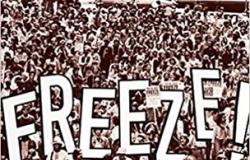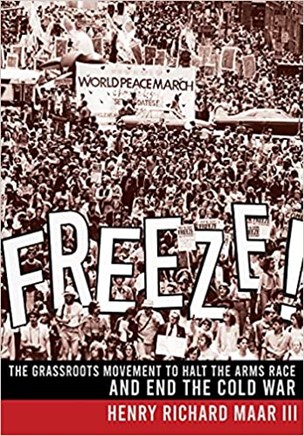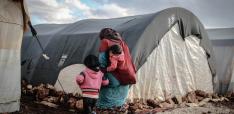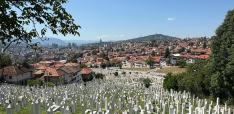Book Review - Freeze! The Grassroots Movement to Halt the Arms Race and End the Cold War

Freeze! The Grassroots Movement to Halt the Arms Race and End the Cold War by Henry Richard Maar III. Ithaca: Cornell University Press, 2021. 300 pp., $51.95 hardcover 9781501760884, $33.99 e-book 9781501760907
The inaugural issue of the Bulletin of the Atomic Scientists in 1947 introduced readers to the “Doomsday Clock.” It displayed a time of seven minutes to midnight, which symbolized the nuclear apocalypse. Following the election of Ronald Reagan in 1980, the clock moved to four minutes before midnight. After a period of détente, superpower relations had soured to such a great extent that many Americans worried about the real possibility of a nuclear war. The Reagan administration’s public pronouncements did nothing to dampen these fears. Yet, on December 8, 1987, the United States and Soviet Union signed the Intermediate-Range Nuclear Forces Treaty, which eliminated U.S. and Soviet land-based intermediate-range and shorter-range missiles, becoming the first agreement to abolish an entire class of nuclear weapons. What happened during the preceding seven years that led to this dramatic reversal in fortune for humankind? As Henry Richard Maar III shows in his well-researched Freeze! The Grassroots Movement to Halt the Arms Race and End the Cold War, the era’s peace movement deserves a large share of the credit for ensuring that the nuclear arms race did not spiral out of control and lead to humankind’s extinction.
 In this wide-ranging account of the nuclear weapons Freeze campaign of the 1980s, Maar takes the reader on a journey through the streets, grassroots strategy meetings, and Americans’ living rooms to the highest levels of the Catholic Church, Capitol Hill, and the White House. At the center of Maar’s story is the debate over a proposed nuclear weapons freeze. In April 1980, Randall Forsberg released her “Call to Halt the Nuclear Arms Race,” which encouraged the United States and Soviet Union to “adopt a mutual freeze on the testing, production, and deployment of nuclear weapons and … missiles and new aircraft designed primarily to deliver nuclear weapons” (p. 35). Though others had floated a similar idea previously, domestic and international conditions in 1980 created a fertile environment for Forsberg’s blueprint.
In this wide-ranging account of the nuclear weapons Freeze campaign of the 1980s, Maar takes the reader on a journey through the streets, grassroots strategy meetings, and Americans’ living rooms to the highest levels of the Catholic Church, Capitol Hill, and the White House. At the center of Maar’s story is the debate over a proposed nuclear weapons freeze. In April 1980, Randall Forsberg released her “Call to Halt the Nuclear Arms Race,” which encouraged the United States and Soviet Union to “adopt a mutual freeze on the testing, production, and deployment of nuclear weapons and … missiles and new aircraft designed primarily to deliver nuclear weapons” (p. 35). Though others had floated a similar idea previously, domestic and international conditions in 1980 created a fertile environment for Forsberg’s blueprint.
Following the end of the Vietnam War and the Strategic Arms Limitation Treaty in the 1970s, the peace and antinuclear movements struggled to stay afloat. A more permanent vehicle for anti-nuclear activists appeared in 1977 with the creation of the Mobilization for Survival (MFS), which sought to bring together peace and environmental activists, as the Rocky Flats Action Group in Colorado had done to oppose the Rocky Flats nuclear weapons facility. Meanwhile, Pam Solo of the American Friends Service Committee and Mike Jendrzejczyk of the War Resisters League formed the Nuclear Weapons Facilities Task Force, which Maar describes as “a critical stepping-stone on the way to the creation of the national Nuclear Weapons Freeze Campaign.” Besides bringing together future leaders of the freeze movement, it also helped “lay the groundwork,” in the words of Maar, for the later campaign by building local activist networks across the country (p. 30). Despite the fallout from the nuclear accident at Three Mile Island in 1979, MFS “suffered from a lack of a cohesive message,” according to Maar (p. 32). Thus, combined with its political and economic struggles, MFS’s inability to create a simple statement of its overriding goal hampered its efforts to reach a wide and diverse audience. This changed when Randall Forsberg gave a presentation at MFS’s second annual meeting in Louisville in December 1979. Rather than discuss the conventional arms trade, Forsberg went off-script, suggesting that the anti-nuclear movement make the proposal swirling around for the United States to initiate a unilateral ban on nuclear weapons production a bilateral measure. Out of this speech came Forsberg’s “Call to Halt the Nuclear Arms Race.”
When the Reagan administration entered the White House the following year, it offered its own alternative to Forsberg’s proposal, though structured in a way that all but guaranteed a Soviet rejection. For instance, the president’s Zero Option called on the Soviet Union to remove its SS-20 missiles from Eastern Europe in exchange for a promise by the North Atlantic Treaty Organization to not deploy the planned, meaning not yet in existence, cruise missiles and Pershing II missiles. Similarly, Reagan’s Strategic Arms Reduction Treaty benefited the United States. It not only allowed the United States to retain more of its current weapons; it also did not mention cruise missiles or bombers, while the Soviet SS-19 remained on the table. The inclusion of throw weight limits also gave the United States an unfair advantage. At the same time, the Reagan administration ridiculed the freeze proposal. More surprisingly, so too did major publications like the New York Times and the New Republic. Nonetheless, events like the June 12, 1982 Disarmament March Rally, attended by more than one million activists, forced the Reagan administration to reckon with the growing movement, albeit without appearing to do so in response to such protests. Indicative of the administration’s concern over the freeze campaign, it created a Nuclear Arms Control Information Working Group led by National Security Advisor Bud McFarlane to develop a public strategy to counter the freeze proposal. This strategy, as described by Maar, involved an effort by the administration to reduce public fears of a nuclear war by claiming that such an outcome could be prevented with further military spending, building on the slogan of “peace through strength”.
On May 3, 1983, the United States Conference of Catholic Bishops released the final version of its pastoral letter, titled “The Challenge of Peace: God’s Promise and Our Response.” Prior to this, as Maar recounts, disagreements between the bishops and with the Vatican resulted in a more nuanced statement. Initially, the pastoral letter included calls for a “halt,” but due to the obstinance of New York archbishop John O’Connor, a conservative Republican, who as a member of Cardinal Joseph Bernardin’s War and Peace Committee rewrote a portion of the draft, the final version replaced “halt” with “curb.” When word spread about the change, the Reagan administration used it to their advantage. Consequently, Bernardine and Archbishop of St. Paul and Minneapolis John Roach had to issue a statement to downplay the revision. Furthermore, Bernardine and Roach sought to show how the latest draft diverged from the Reagan administration’s approach to nuclear strategy, including the document’s support of no first use and for setting ceilings on nuclear weapons. Maar describes the bishops as inhabiting a “third way” to distinguish their pastoral from both President Reagan and the freeze movement (p. 94).
By the end of 1982, Maar argues that the “more populist” bent of the early freeze movement gave way to an electoral approach (p. 115). After several false starts in the years prior to 1983, and after a long, drawn out debate that resulted in twenty-five amendments being attached to the bill, the House of Representatives voted in favor of a freeze resolution and mutual arms reductions. While a victory for freeze proponents, it proved hollow. The nonbinding resolution lacked a timeline for enacting a freeze and an amendment introduced by Henry Hyde (R-IL) and Elliot Levitas (D-GA) included a sunset provision that required action within a certain period, or the freeze would become null and void. Nor did the resolution do anything to limit spending on weapons systems or stop the deployment of the Euromissiles. Despite the limitations of the bill, Maar suggests that its passage “moved the administration closer to a new detente” (p. 126). However, when the Senate voted on the Kennedy-Hatfield freeze resolution, amid the downing of Korean Airlines flight 007 by the Soviet Union, which led to the deaths of all 269 aboard, including Representative Larry McDonald (R-GA), the measure failed to pass.
By 1985, the Freeze movement had already reached its nadir. Nonetheless, Maar contends that the need for the campaign no longer existed as nuclear fears diminished and Soviet leader Mikhail Gorbachev “stepped into the space the movement was vacating, implementing its ideas” (p. 220). Indeed, representatives from the Freeze movement had joined a delegation that met with Gorbachev in 1985. Though beyond the scope of Maar’s excellent book, future researchers might look into how not only American, but also European, anti-nuclear activists interacted to bring European and Soviet officials around to the idea of a freeze and, eventually, nuclear disarmament.
Dr. Brian S. Mueller teaches history at the University of Wisconsin-Milwaukee.


